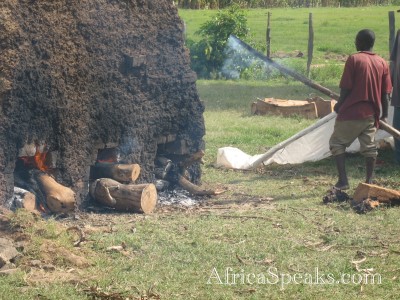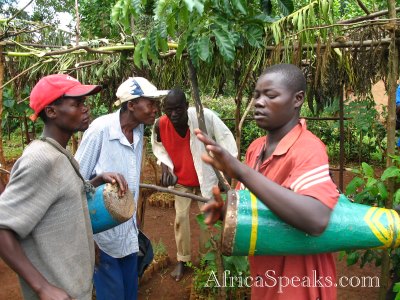The original URL of this article is:
www.africaspeaks.com/kenya/18102006.html
The Culture of Kenya and Trinidad and Tobago
by Akinlabi Holder
October 18, 2006
UWI Students Trip to Kenya
 | | | Akinlabi Holder | |
The experience gained on our trip is one that will definitely be unforgettable. Africa is such a vast, breathtakingly beautiful place full of warm and pleasant people who work hard to secure a future for themselves, their families and future generations. Many of us complain about our standard of living in the Caribbean. Compared as to how a lot of Kenyans are living I believe that we should be grateful for what we have (this does not mean that we must settle). The amazing thing about the Kenyan people we have interacted with is that though they are living in what we call sub- standard and without what we call "necessities" they had a very positive outlook on life and were satisfied. This is something that we could learn from them. Even though we have access to all sorts of luxuries that supposed to make our lives happier we still tend to be depressed or unsatisfied. Yet they have some of the most basic needs and are satisfied.
During the centuries of slavery and colonialism by the Europeans and even further back to the slavery and colonialism by the Arabians centuries before, Africa was robbed of almost everything that she owned. Her culture and religion was forced out of the minds of her people and replaced with that of the Arab world and the European world. This paper looks to discuss the notion of a "Third world art and culture" and comes to a conclusion of whether it exists or not.
 | | Heating up the brick oven |
If there is one thing that unifies every race, class, nationality and religion is the existence of a culture. It is the one part of life that cannot be escaped, culture can be defined as the way of life of a group of people. As there are various races, nationalities, tribes or whatever there are different cultures. There are different ways of life, different ways of going about everyday life interactions. In the twentieth century we have seen a unification of cultures due to colonialism, and more recently globalisation. We have seen countries, which were once colonies and are usually third world, adopting the culture of the colonizers, typically first world nations. Even more accountable for the "cultural unification" than the colonization is the globalisation that is taking place right now. It (globalisation) can be seen as the intimate communication of countries and regions, which is mainly done through trade, and technology. The situation in Kenya can be seen as having similarities to Trinidad and Tobago. There are certain aspects of cultures in third world countries that are common or show similarities in some way. Still this does not say that there is such a thing as "third world art and culture". What this paper will be seeking to look at is the culture of Kenya that was present before foreign influence and how this has changed with the influences from other countries. I will then seek to show how similar it is to the situation within Trinidad and Tobago in an attempt to bring some light to the notion of "third world art/culture".
Let us first look at what "third world art" can be. The art in Kenya is mainly handcraft. A tribe called the Maasai is well known for their beadwork, which not only has an ornamental purpose but also serves as a means to differentiate the age set system. The men use the beads also as a means to enhance their appearance. Some women in Kenya also make a jewelry called Kazuri. Women, who have no other means of making a living, usually undertake this. The word Kazuri means "small object of great beauty" this is also beadwork (some would have wooden or stone pendants). This is similar to the beadwork that is seen selling on Store Bay. Also there were a good bit of sculptures out of wood and stone. I bought a chess board made out of stone and the pieces were also made out of stone, but the different pieces were represented by animals such as lions and elephants. They also make a lot of textile products, such as wraps, skirts, sisal baskets, elephant hair (not real), paintings, Maasai figurines and the most famous Maasai cloth (bluegecko.org). As is the case in Tobago, most of the artwork is done for the Maasai market to sell to mainly tourists.
As we know there are various types of art, therefore we would not look only at the visual aspect of it. In Kenya, it was observed on our visit to some of the primary schools, they took a different approach to battling the HIV/AIDS epidemic. A lot of the schools have decided to heighten social awareness and HIV/AIDS education and sensitization through theatre. One of the sketches that we saw educated the audience of the purposes the blood cells and how the AIDS virus affects the body. The theatrical arts are also used to bring forward the changes in society e.g. there was one performance that commented on the changes in the way women dressed now and how revealing there clothes were. In Trinidad and Tobago it is the same in a way. While it is not common for the schools here to use theatre to bring about awareness on any issue, some groups that involve young people do use theatre to try to educate people about things such as drugs, STDs and religious education.
 | | School children doing a skit |
The musical art is the last aspect of art that I will look at. Most of the musical art forms of Kenya are sort of the folk music type. A lot of the tribes have their own type of music, and a lot of the music was for functional purposes. The Banjuni tribe would sing a Mashindano Ni Matezo (a work song), which is sung mainly to relieve workers of a sense of boredom from tedious tasks. The Maasai did not use any instruments, but used mainly polyphonic vocal music. The Samburu people have few instruments such as pipes and a guitar like instrument. They use their music for good fortune at times; the women will sing erotic songs when praying for rain. The Turkana tribe of northern Kenya has been one of the few tribes that have held on to their tradition. They sing mainly in a call and response and they play an instrument made from the kudu antelope. The Luo people used their music for many purposes, such as ceremonial, incidental, political and religious purposes. In funerals, music was used to praise the deceased, console the grieving, express pain and to cleanse and chase away spirits. Songs were also used at joyous times, such as beer festivals, courtship and wrestling matches. Work songs were also used in this tribe also, they would usually be sang at communal duties like building structures, weeding the fields etc. and individual work like pounding cereal. The Akamba tribe has their traditional music divided into age groups. The elderly men and women perform Kilumi, which is a dance song. The Mbeni is for young and acrobatic boys and girls. The Kyaa is also for the elderly (no information was given about what these songs were for). Many of these songs involve a call and response, so do folksongs from Trinidad and Tobago. Yet this does not give proof to a third world culture because many folksongs of America also involve a call and response.
Even though I have mentioned a good number of traditional musical art forms that exist within Kenya a lot of Kenyans don't know of them. A lot of these traditional art forms and others have disappeared and now many Kenyans think of traditional music as gospel music. The Kenyan music scene has seen a lot of foreign influences shaped the Kenyan music of today. In the 1950's saw the rise in popularity of Congolese music called Benga.
In Trinidad and Tobago the art forms that can be said to be of this country i.e. created here; calypso and chutney. Although there are many folksongs in this country, like as in Kenya not many people know of them. Also like Kenya this country also started to be influenced by foreign music from the first world countries in the 1950's and the influence got heavier as the decades went along. This can be seen by the changes in the preference in mainstream music in Kenya. The Congolese musicians had the heaviest influence on Kenya; Benga soon became the most popular art form. In Trinidad and Tobago, soul music of the African- American community started to penetrate the mainstream that calypso held for so long. Still both countries held onto their identities and came up with something that was unique to them. Kenya came up with something called Kenyan pop. The art form is slightly different to the original art form, Congolese pop; the Kenyan version is sung in Swahili instead and has other local influences. The influence of soul music and calypso in Trinidad gave way to the development of something new, in the early 1970's the calypsonian Ras Shorty I. Soca (soul and calypso) was born. It also tapped into the East Indian influence within this country using the rhythms of the Indian drums. The influences of the more powerful nations led to a blend of cultures, and although aspects of the "exploited" nations' culture were eroded, they were able to form something new that could be also called local. This is even more evident as the 1980' came to an end in Kenya. Pop music was replaced as the preferred mainstream music by hip-hop. As the music grew more popular, Kenyans began to add their own flavour to the hip-hop songs coming out of that country. In the early 1990's not only did hip hop become popular but the Jamaican art form called dancehall also gained recognition and gave way for something new to be formed in Kenya. Genge, which is a mixture of hip-hop, raga (blend of dancehall and reggae), R&B and dance pop, came about. It is sung with a mixture of English, Swahili and the various tribal languages (commonly called Sheng). The topics and sadly the accent, however, are very reflective of those hip hop songs of America. In Trinidad and Tobago, the music scene diversified even more when Ragga Soca (a mixture of dancehall and Soca) in the mid-nineties gained popularity. This was first started by Jamaican Soca band Byron Lee and the Dragonaires in the early 1990's. Artistes such as Ghetto Flex and KMC then took it up and became the pioneers of the new type of soca music. This was not the only diversification of the music industry of lately, of last year a local reggae industry emerged and seems to be thriving both at home and in other countries.
 | | Men of Shikunga Village |
The changes in the genres of music and the adaptations of others can be seen as having a connection with changes in the cultural thinking of the population. Our host in Kenya lamented that only about 15% of the original culture of Kenyans remains today. A lot of people have no idea of what Kenyan culture is. This is a result of colonization by the British and the divisive tactics they used (putting tribe against tribe) while imposing their ideologies on every aspect of life upon the masses. This was done even more effectively with the church missionaries who taught the will of the colonizers with their religion. These factors have led to an almost full westernization of Kenya. This can be seen in the way that they dress (European style) and moral value adoptions e.g. monogamy as a result of a conversion from their ancestral religion to Christianity. Westernization can be seen all clearly in Kenya by the use of English as one of its official languages. Although Kenyans are proud to speak Swahili and do speak it more often than they do English some of my colleagues observed that when we spoke to them in Swahili they responded in English. That, to them was a sign of a rejection of their culture. However, I discredit those concerns and look at that situation as a means of making communication between themselves and foreigners easier and simpler.
Globalization and the increase of access to computers and television by the general public have led to an increase of foreign influences on Kenyan life. While some tribes practiced what will be called sexual promiscuity by Western standards. For example some tribes allow women to still have sexual relationships with their past boyfriends even though they are married. Some tribes allow their young girls who have not reached puberty to have sex with the young teenage "warriors", but they must get married as soon as they reach puberty to avoid having children out of wedlock. Still, many of the tribes practiced monogamy and they never really had any problems with any diseases. With the "introduction" of "western style promiscuity" perpetuated by the culture of Hip Hop music from America has led to devastating results for Kenya. This has left the Kenyan government locked in a vicious anti-AIDS campaign as the disease has wreaked havoc. Another effect of exposure to western culture is the phenomenal increase in homosexuality in Kenya. Many of the older people seem to be perplexed by the change in sexual preferences by the young people. This case is quite similar to that of Trinidad and Tobago, the strong influences of American culture through the media has resulted in the replacement of "old time values" for those of the United States and other European nations. As in Kenya the effects are the same. Still there is a question of whether, in the case of the homosexuals, that they are "coming out of the closet", or otherwise. These points still do not point to anything that shows a" third world culture". One of the more disturbing occurrences taking place in Kenya and that has been in existence is discrimination. As mentioned before the colonial powers used to practice divide and rule tactics. The British used to put tribe against another tribe, these tactics are similar as to what happened when the colonial powers in Trinidad, also the British separated, put the Indians against the Africans. There is a serious discrimination between the various tribes, in cases of employment an employer would give preference to people of their own tribe. Even though these days there have been inter-tribal marrying it is not something that a lot of the elderly people in the different tribes promote.
Recent attempts by the authorities to establish a national dress for all Kenyans (I suspect that this was attempted to bring about national unity) failed as some tribes felt that they were not represented fully or not represented at all. There is a similar situation in Trinidad and Tobago. The fighting of the two major races in the country (Africans and Indians) which is fuelled even more by politics based along racial lines gives way to discrimination in society. Unlike in Kenya there was never any attempt to establish a national dress. The government's lack of proactive behaviour over the years by the government in relation to culture of the people is evident by the non-existence of a Ministry for Culture. Still, the people do hold on to some of the little things that distinguish them as Kenyans.
Culture is not something that can be put into brackets of belonging to a first world or a third world. Cultures, especially in this modern world are common to many areas due to spread of the diasporas and the spread of the different religions. Even though it may seem that most third world countries are rejecting their cultures and assimilating to that of the First World, they still seem to find a way to add to it (first world culture) their own "touch". We mix our cultures with theirs to come up with something new that is unique to our respective countries. There are certain things that happen in a third world country that just will not happen in a first world nation. There then can be said that there are certain characteristics that make up a third world culture but the lines are becoming increasingly blurred.
UWI Students Trip to Kenya in pictures:
http://rastafarispeaks.com/gallery/Trip_to_Africa_2006
|
|